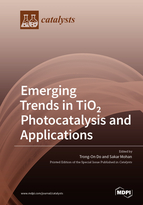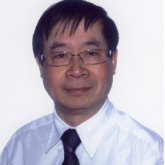Emerging Trends in TiO2 Photocatalysis and Applications
A special issue of Catalysts (ISSN 2073-4344). This special issue belongs to the section "Photocatalysis".
Deadline for manuscript submissions: closed (31 March 2019) | Viewed by 173234
Special Issue Editors
Interests: hydrogen production; hydrogen evolution; catalysis/photocatalysis; nanomaterials; clean energy; solar fuels; environment
Interests: photocatalysis; biomass conversion; perovskites; multiferroics; plasmonics; nanomaterials for energy and environmental applications
Special Issue Information
Dear Colleagues,
The photo-assisted catalytic reaction, which is conventionally known as “photocatalysis”, is blooming in the field of energy and environment due to its multifaceted applications, such as in pollutant degradation, water splitting, fuel conversion, anti-microbial activities, etc. The photocatalytic process involves the separation of excitons upon light irradiation, and their subsequent transfer to the respective band energies (electrons to the conduction band and holes to valence band) to perform reduction and oxidation processes in order to execute the required transformation reactions. The key requirement to achieve the required application is to engineer a photocatalytic material with suitable band edge positions to produce the appropriate redox species.
In this direction, titanium dioxide (TiO2) is one of the well-established and renowned photocatalysts that has been explored for various possible photocatalytic applications. However, along with suitable band edge positions, an efficient photocatalyst should also have (i) a narrow band gap energy so as to absorb visible light energy, (ii) enhanced charge separation, so as to have high quantum efficiency, (iii) enhanced recombination resistance to have prolonged reactions, and (iv) effective interfacial interactions to have intimate contact between the surrounding media and the photocatalyst, towards total conversion of the reactant.
To handle these requirements in a photocatalyst, several modifications strategies have been developed, which broadly include doping, composite, plasmon sensitization, co-catalyst loading, integration of carbon-based materials, anisotropic nanostructuring of the photocatalyst, etc. As TiO2 is a pioneering material for any developments in the field of photocatalysis, this Special Issue is going to be focused on “Emerging Trends in TiO2 Photocatalysis and Applications”, featuring the state-of-the-art in the field. Research findings focusing the fundamental exploration of the syntheses, characterizations and applications in technological- and industrial-scale development of TiO2 in the field of photocatalysis are of prime importance to this Special Issue.
Above all, we are glad to highlight that Prof. Akira Fujishima will be contributing a review paper in this Special Issue highlighting the recent trends in the field and featuring the modern photocatalysis.
Prof. Dr. Trong-On Do
Dr. Sakar Mohan
Guest Editors
Manuscript Submission Information
Manuscripts should be submitted online at www.mdpi.com by registering and logging in to this website. Once you are registered, click here to go to the submission form. Manuscripts can be submitted until the deadline. All submissions that pass pre-check are peer-reviewed. Accepted papers will be published continuously in the journal (as soon as accepted) and will be listed together on the special issue website. Research articles, review articles as well as short communications are invited. For planned papers, a title and short abstract (about 100 words) can be sent to the Editorial Office for announcement on this website.
Submitted manuscripts should not have been published previously, nor be under consideration for publication elsewhere (except conference proceedings papers). All manuscripts are thoroughly refereed through a single-blind peer-review process. A guide for authors and other relevant information for submission of manuscripts is available on the Instructions for Authors page. Catalysts is an international peer-reviewed open access monthly journal published by MDPI.
Please visit the Instructions for Authors page before submitting a manuscript. The Article Processing Charge (APC) for publication in this open access journal is 2700 CHF (Swiss Francs). Submitted papers should be well formatted and use good English. Authors may use MDPI's English editing service prior to publication or during author revisions.
Keywords
- Honda-Fujishima effect
- Band gap engineering
- Doped TiO2
- TiO2 based composites
- Nanostructured TiO2 photocatalyst
- Plasmonic TiO2 photocatalyst
- Defective TiO2 photocatalyst
- Visible light driven TiO2
- Pollutant degradations
- Water splitting
- Fuel conversions







